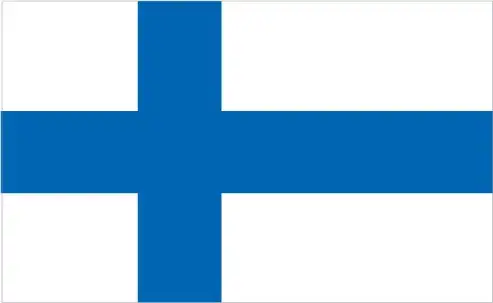Finland Flag
National Flag of Finland
Finland Flag Display

Quick Facts About Finland and Finland Flag
- Adopted:
- Aspect Ratio:
- 11:18
- Capital:
- Helsinki
- Population:
- Approximately 5.5 million (2023)
Flag Description
The national flag of Finland, commonly referred to as the 'Blue Cross Flag' (*Siniristilippu*), features a deep blue Nordic cross set against a pristine white background. Its clean and balanced design exemplifies Finnish identity and its place within the family of Nordic nations. The flag’s structure follows the traditional Scandinavian layout with the vertical part of the cross shifted toward the hoist, a design that reflects cultural cohesion with other Nordic countries like Sweden, Norway, and Denmark.
Symbolism & Meaning of the Finland Flag
The white field of the Finnish flag represents purity, honesty, and the snow that covers the Finnish landscape for much of the year. It evokes the serene beauty of Finland’s vast wilderness and winter-dominated climate. The blue cross stands for the thousands of lakes that are scattered across the country and the clear skies that shine over the north. Together, the colors express a strong connection to nature, calm strength, and the peaceful spirit of the Finnish people. The cross design also signifies Finland’s historical connection to Christianity and the broader Nordic community.
Historical Background of the Finland Flag
Before Finland's independence, flags associated with the country typically included Russian symbols due to its status as an autonomous Grand Duchy under the Russian Empire. As national consciousness grew in the 19th century, poets and intellectuals proposed various designs to represent a unique Finnish identity. The blue and white color scheme was popularized by cultural figures long before independence. After Finland declared its independence from Russia in December 1917, a national design competition led to the official adoption of the current flag on 29 May 1918. This choice symbolized a break from imperial influences and embraced Nordic heritage and Finnish natural beauty.
Design Elements of the Finland Flag
The flag features a white field with a blue Nordic cross that extends to the edges. The cross is offset toward the hoist side, in line with traditional Scandinavian cross flag layouts. The official shade of blue used is a deep ultramarine (Pantone 294 C), symbolizing water and sky. The vertical-to-horizontal bar proportions are 4:3:4 and 4:10:4, giving the flag its standard 11:18 aspect ratio. State variants of the flag include a version with the Finnish coat of arms centered on the cross, and a swallow-tailed flag is used by the military and the President of Finland.
Usage & Protocol of the Finland Flag
The display and handling of the Finnish flag are governed by national law and longstanding traditions. It must be hoisted at sunrise and lowered at sunset, though no later than 9:00 PM during summer months. It is never to be flown in a damaged or dirty condition, and worn flags must be disposed of respectfully, typically by burning. The flag is flown at half-mast as a sign of mourning or national tragedy, and specific days are designated as official flag days, such as Independence Day on December 6, Midsummer Day, and the birthdays of notable national figures. A unique aspect of Finnish flag culture is the use of household pennants, narrow vertical streamers flown year-round to indicate that the residents are home, blending national symbolism with daily life.
Frequently Asked Questions
What do the colors of the Finland Flag represent?
The white field of the Finnish flag represents purity, honesty, and the snow that covers the Finnish landscape for much of the year. It evokes the serene beauty of Finland’s vast wilderness and winter-dominated climate. The blue cross stands for the thousands of lakes that are scattered across the country and the clear skies that shine over the north. Together, the colors express a strong connection to nature, calm strength, and the peaceful spirit of the Finnish people. The cross design also signifies Finland’s historical connection to Christianity and the broader Nordic community.
When was the Finland Flag adopted?
The Finland flag was adopted on 29 May 1918, marking an important milestone in the country's development as an independent nation.
What is the aspect ratio of the Finland Flag?
The Finland flag has an aspect ratio of 11:18, which determines the proportional relationship between its width and height for official display purposes.